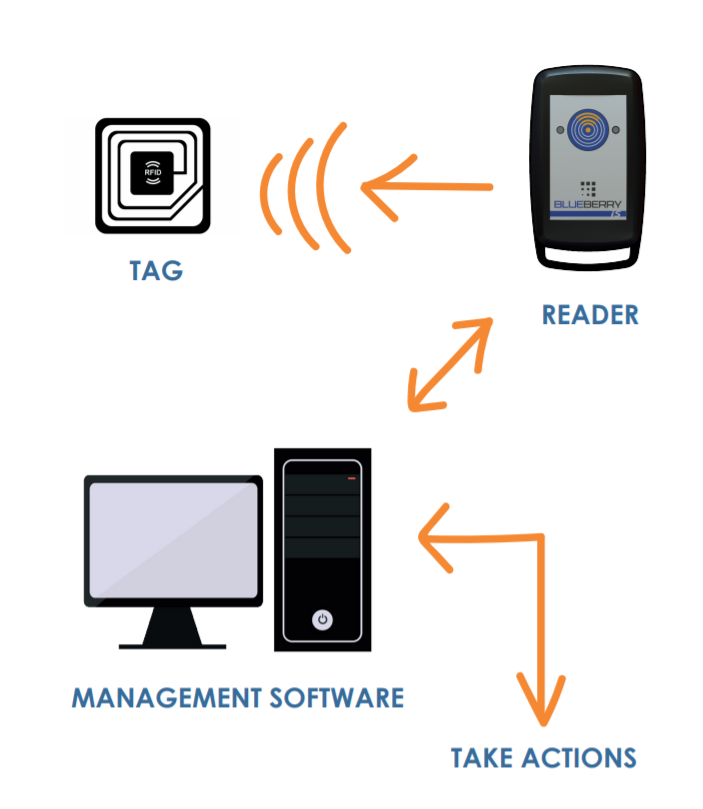Most RFID systems consist of three elements:
- Tag: It’s composed of an antenna to transmit and to receive signals and an RFID chip that contains information on the object to which it’s affixed;
- Reader: It’s the mind of the RFID system and it’s necessary for the operation of any system. The reader is used to query and receive the information contained in the tag;
- Management Software: allows you to manage information coming from the tag and enables users to make informed decisions and take action.

The advantages of RFID technology in terms of efficiency are innumerable.
However, its adoption within a company requires a precise and accurate analysis in order to guarantee the success of the RFID project.
If you want to implement RFID technology within your organization with excellent results read the 8 steps below!
1. Identify the problem
Let’s start from the assumption that a well defined problem leads to a well defined solution. To maximize the benefits deriving from the adoption of RFID, it’s necessary to identify the bottlenecks and inefficiencies in the existing processes. However, it should be emphasized that RFID is not the panacea for all ills. If the company has organizational structure problems radio frequency technology alone cannot solve them. It will be up to the company itself to be ready to embrace a more comprehensive change programme in order to eliminate these problems.
2. Set goals
It’s essential to set measurable goals to ensure that expectations are met. This step will be essential to ensure that the actions carried out in the field can then be translated into expected results.
3. Estimate Costs
Before running an RFID implementation, the company must estimate the costs of the project. The type of activity that is performed and the type of technology used, determine the amount of the investment required. The cost estimates will be different between an implementation in a warehouse environment where RFID will be used for inventory tracking and an implementation in a retail store where RFID will be used to trace valuable products. In each case the company will be faced with different technologies and therefore different costs. Correctly identifying costs in the project pre-realization phase is important because, in addition to estimating the overall capital outlay for the implementation, it provides an overview of the potential return on investment (ROI) that can be obtained by adopting RFID.
4. Map the business process
Mapping clearly the operational processes is fundamental to obtain a systemic view of the flow and to identify the situations in which RFID technology must be implemented. When the analysis of the process is not carried out accurately, the use of technology, despite the commitment of time and the money spent does not solve the problem.
5. Choose the appropriate technology
For each RFID project, you need to choose a specific technology. One of the first decisions to make is whether to use an active or passive tag. Localization at greater distances requires the use of the former, while for smaller objects that need to be located in limited areas the latter is used. RFID tags are available in different shapes, sizes, models and applications. The choice of readers is equally important, they can be fixed or mobile and have different reading distances depending on the power. Another element that affects the type of RFID technology to be adopted is the environment. A careful evaluation of the place and of the environmental conditions are of fundamental importance for the selection of the most suitable devices and tags.
6. Train the team
If a company decides to implement RFID technology, it must ensure that all employees are informed about the main features of RFID: what it is, how it works, its limitations, etc. In addition, key project people should receive more in depth training on the technology in question. The more the employees are aware of how to manage RFID technology, the more effective the system will be as they will be able to intervene adequately if necessary.
7. Execute a pilot
In the implementation phase of the RFID project, running a pilot project ie a small scale project to evaluate the cost benefit analysis and obtain feedback on the choices made regarding the technology adopted (reader, tag, software) should be considered.
Running a pilot is important because it allows the system to be modified before completely implementing the solution.
8. Expand the solution
When the pilot project has been successful, it’s possible to extend the implementation of RFID to other areas. Once the expansion project is completed, the advantages and set goals will be achieved.
A radio frequency identification system will be a success if, when defining the requirements, we follow the right steps!
Get your free PDF guide ⇓⇓⇓
8 STEPS FOR A SUCCESSFUL RFID IMPLEMENTATION
Send PDF to:

